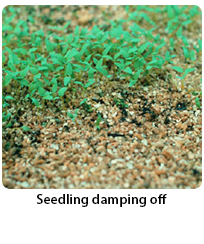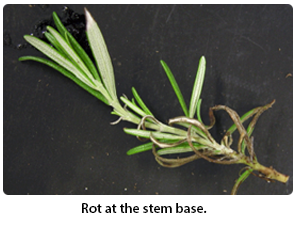While not all species of Pythium cause crop losses, some species of Pythium cause significant diseases on several important, mostly herbaceous, crops. They have a broad host range and disease development is highly dependent on environmental conditions. Some species require, moist and cool conditions (such as Pythium irregulare and P. ultimum) while others are most severe at higher temperatures (such as Pythium aphanidermatum and P. myriotylum). Plant diseases caused by Pythium are divided in two types: diseases that affect plant parts in contact with the soil (roots, lower stem, seeds, tubers, and fleshy fruits) and diseases that affect above ground parts (leaves, young stems, and fruits) (1).
Some Pythium species infect roots of mature plants, typically causing necrotic lesions on root tips or fine feeder roots and, less commonly, on tap roots. Pythium infections are usually limited to the meristematic root tips, root epidermis, cortex of roots, and fruits; but occasionally, severe infections occur when the pathogen moves deeper into the plant tissue and reaches the vascular system. They are important pathogens that cause root rot of several crops in hydroponic culture (18).

If soil is infested with Pythium, pre-emergence damping-off occurs when the seeds are colonized during germination and become soft, turn brown, and disintegrate (1). In post-emergence damping-off the seedlings are infected right after germination. Seedlings that emerge are usually infected at the roots or stem below the soil line. The area becomes water soaked and collapses causing the seedling to collapse at the soil line. When older plants are infected with Pythium they are sometimes not killed even though they develop root rot. However sometimes, the plants die.
After Pythium colonizes the roots it will cause extensive damage to the root system. The symptoms associated with root rot include lack of small feeder roots, brown lesions in the roots, and loss of cortex (rat tail like appearance with the central column of vascular tissue remaining intact while the outer cortex cells fall away).


The pathogen may proliferate and move from the root to other parts of the host plant. If the plant survives, Pythium may colonize the stem and cause stem rot. The stem will turn brown with extensive damage to the vascular system leading to the lack of water transportation to the leaves and the death of the plant. Sometimes plants infected with Pythium are only stunted as compared to a healthy plant and do not die. In general, plants that rapidly produce new roots and have an extensive root system are better able to cope with and survive Pythium infection while plants that have a relatively weak root system rapidly succumb.


When examining roots that are in poor health, you may not see spherical sporangia or oospores. It is difficult to see the hyphae among the root cells. Therefore, Pythium may be present even if oospores are not observed. When in doubt, plate it out!


Pythium can also cause diseases in animals. Pythium has been associated with very wet pastures where horses with open wounds graze and the wounds become infected with Pythium. Humans have contracted Pythium infections in aquatic environments such as swimming areas and through Pythium-contaminated contact lens soaks. Also in humans, Pythium has been found to secondarily invade severely injured tissues. Relatively recently, Pythium has been found to infect the gastrointestinal tract of cats (12; 5; 14; 4).

